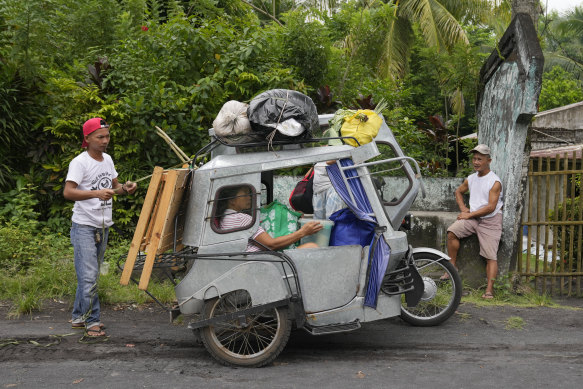
Aside from villagers living in communities perilously close to the volcano, authorities and villagers began moving large numbers of cows and water buffaloes on Sunday from high-risk farms to 25 temporary grazing areas a safe distance away. They’re following more than 12,600 villagers who have moved to emergency shelters since last week, when Mayon began spewing superheated gas and producing heavy ashfall in a sign of a possible major eruption imminent within days or weeks.

Residents living near the Mayon volcano prepare to move to an evacuation centre on Sunday.Credit: AP
“It’s not only people that should be brought to safety but their farm animals too,” Albay provincial veterinarian Manny Victorino said. He said authorities were taking steps to avoid a deeper economic impact should the volcano erupt.
In Matnog village in Daraga town, Victorino and his team of veterinarians provided deworming medicine, injected vitamin supplements and punched identifying tags onto the ears of several cows and buffaloes for better monitoring.
The cattle evacuations underscore the government’s dilemma in dealing with threats from about two dozen active volcanoes, led by Mayon, spread across the sprawling archipelago. Located in the so-called Pacific “Ring of Fire,” a region prone to earthquakes and volcanic eruptions, the Philippines is also lashed by about 20 typhoons and storms a year, making the Southeast Asian nation one of the world’s most disaster-prone.
On Sunday morning, throngs of people jogged or biked, joined a group dancing to disco music and walked their dogs in a seaside promenade in Legazpi. The volcano lay hidden in thick clouds at a distance.
Loading
A resident, Violeto Peralta, caught the attention of passersby, painting an image of Mayon’s explosive eruption on the concrete fence of his roadside house. Passing schoolchildren, he said, would be happy to use his painting as a backdrop for their selfies.
He said that many businesses in the province have grown rich from diverse tourist activities that have sprung from Mayon, including sightseeing tours around the country’s most active volcano.



























